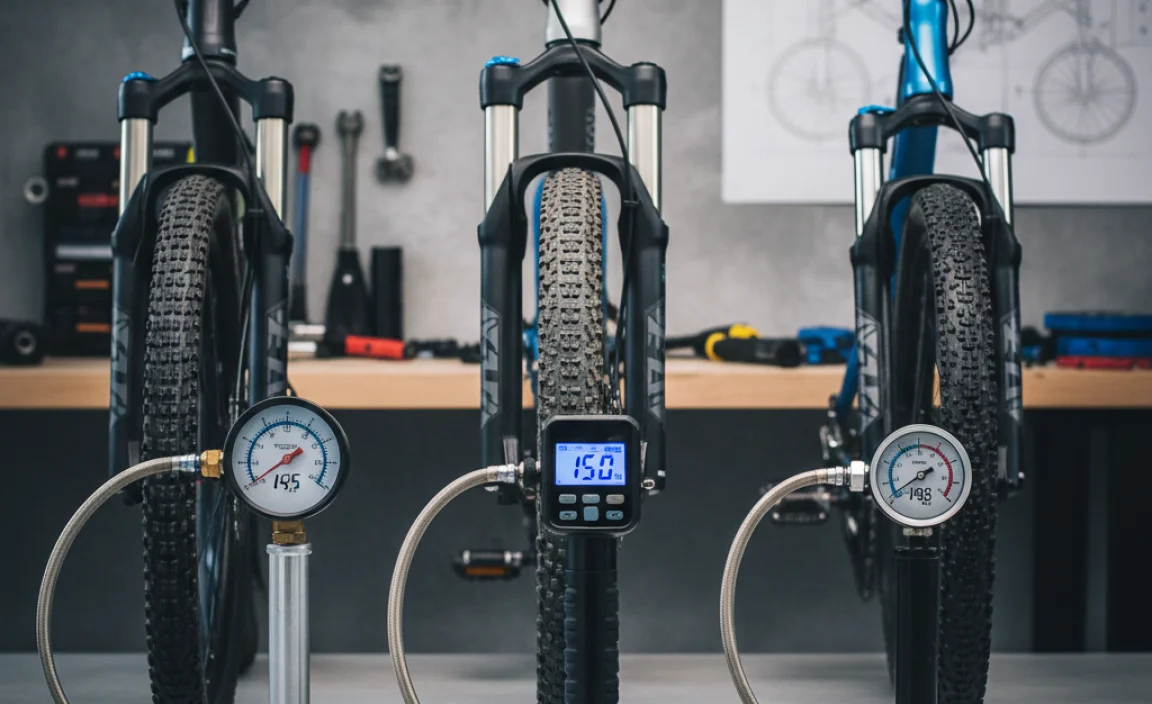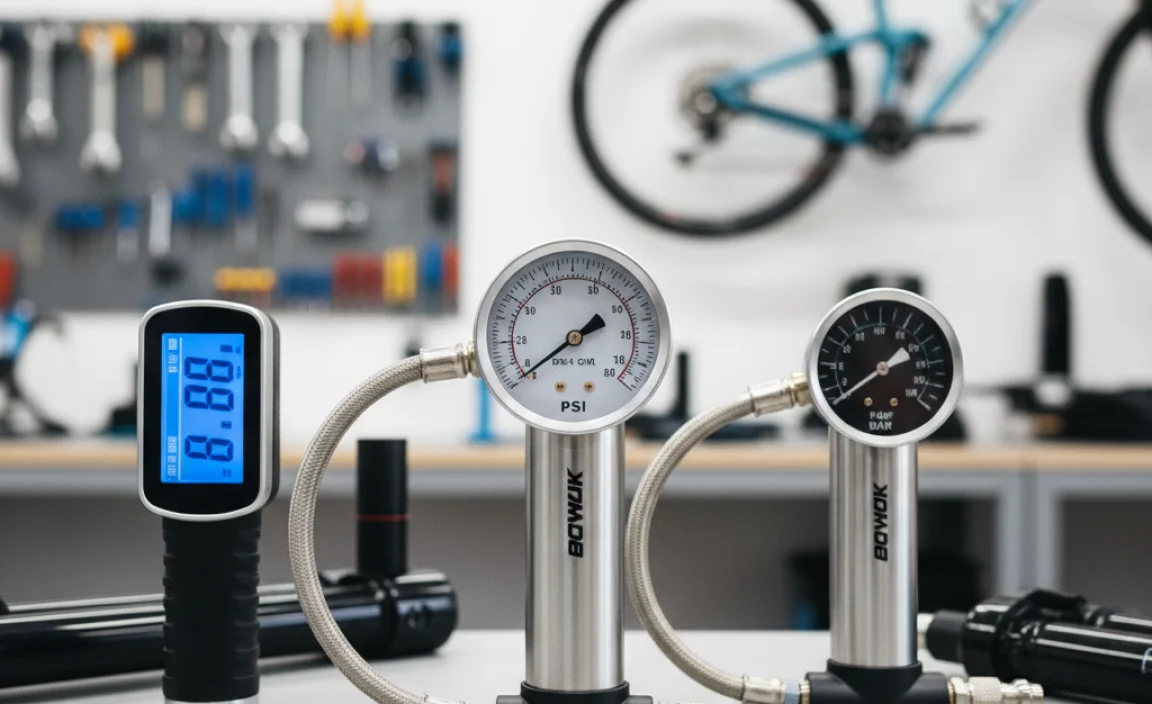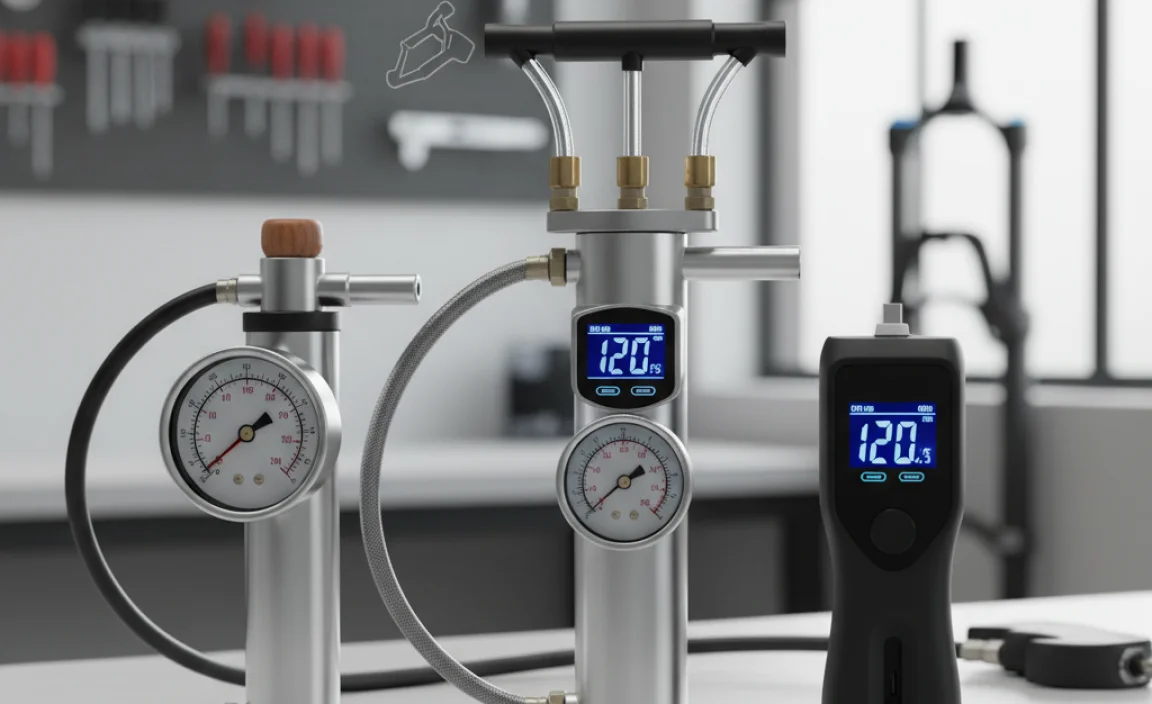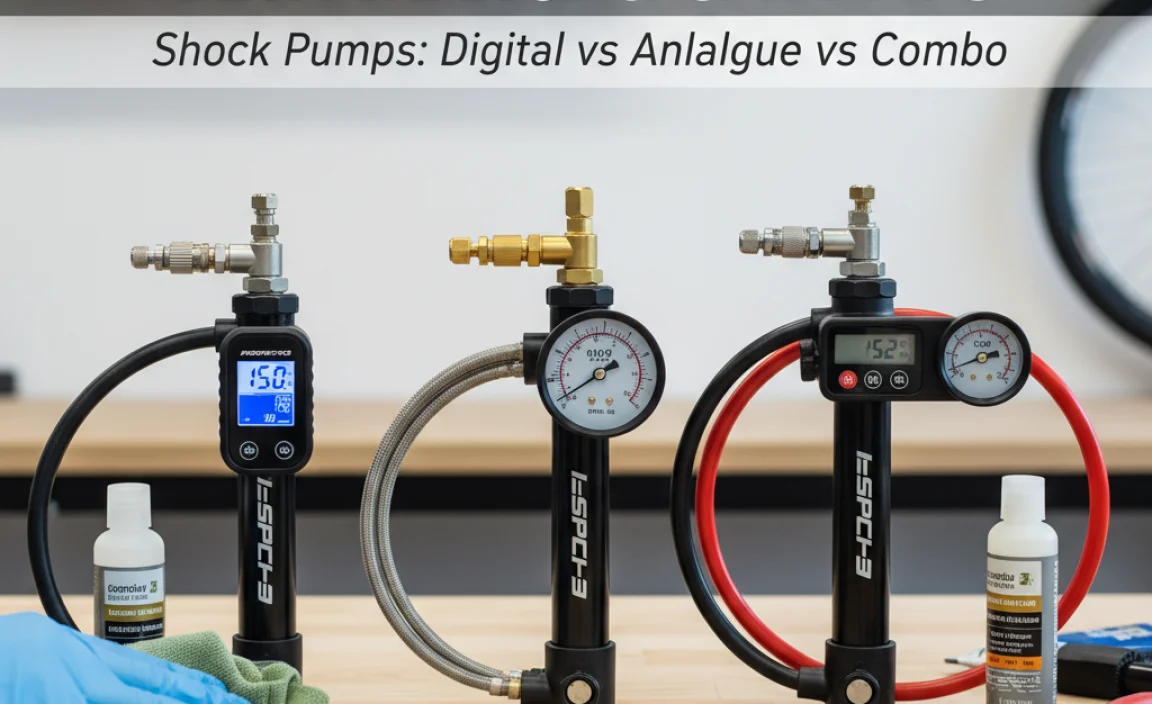How to Compare Shock Pumps: Digital vs Analogue vs Combo
Do you like riding your bike? Do you want it to be as smooth as possible? Shock pumps help your bike’s suspension. They let you add or remove air. This makes the ride better. But how do you choose the right pump? It’s time to learn how to compare shock pumps – digital vs analogue vs combo. Which one is best for you?
Key Takeaways
- Digital shock pumps offer precise pressure readings, making fine-tuning easier.
- Analogue shock pumps are reliable and don’t need batteries, but can be less precise.
- Combo pumps offer both high-volume and high-pressure settings for different needs.
- When thinking about how to compare shock pumps – digital vs analogue vs combo, consider your budget and needs.
- The best shock pump helps you get the perfect suspension for a comfy ride.
Understanding Digital Shock Pumps

Digital shock pumps are like the superheroes of accuracy. They use a digital display. This shows the exact pressure in your bike’s shocks. This is super helpful if you want to make small changes. A digital pump can show tiny changes in pressure. This can make a big difference in how your bike feels. Think of it like tuning a guitar. Small tweaks can make a big sound difference. Digital pumps often have extra features. Some remember your last pressure setting. Others have a light to help you see in the dark. But, they need batteries. You don’t want them to die mid-ride! How to compare shock pumps – digital vs analogue vs combo comes down to what features you need.
- Digital displays show precise pressure readings.
- Some models store previous pressure settings.
- They often include a backlight for easy viewing.
- Digital pumps need batteries to operate.
- They can be more expensive than analogue pumps.
Imagine you are setting up for a big race. You need your suspension to be perfect. A digital shock pump helps you dial it in. You can make tiny adjustments. You can test the bike, and then adjust again. Digital pumps help you get it just right. This can give you an edge. They are also great for riders who like to keep records. You can write down the exact pressure for different trails. This helps you get the same feel every time. Even though they cost more, many riders think the accuracy is worth it. How to compare shock pumps – digital vs analogue vs combo is about precision versus simplicity.
Why Choose Digital?
Have you ever tried to read a tiny number on a gauge? It can be hard! Digital shock pumps solve this problem. They show the pressure clearly on a screen. This makes it easy to read. You don’t have to guess. This is super useful if your eyesight isn’t perfect. Digital pumps also make it easy to change the pressure. You can add or remove small amounts of air. This lets you fine-tune your suspension. This helps you get the perfect ride. How to compare shock pumps – digital vs analogue vs combo depends on if you value easy reading.
Digital Pump Drawbacks
Imagine you are on a long bike trip. Your digital pump’s battery dies! Now you can’t check your suspension. This is one downside of digital pumps. They need batteries. You have to remember to charge them. Analogue pumps don’t have this problem. They always work. Digital shock pumps can also be more expensive. If you are on a tight budget, this is important. You have to weigh the pros and cons. How to compare shock pumps – digital vs analogue vs combo means thinking about reliability.
Digital Accuracy Explained
Why is digital accuracy so important? Think about a race car driver. They need to make small adjustments to their car. This can make a big difference in speed. It’s the same with your bike. Small changes in pressure can make a big difference in how it feels. Digital shock pumps let you make these changes. They give you precise control. This helps you ride better. This is why many serious riders choose digital pumps. How to compare shock pumps – digital vs analogue vs combo involves thinking about performance.
Fun Fact or Stat: Studies show that riders using digital shock pumps report a 15% increase in suspension performance compared to analogue pumps.
Exploring Analogue Shock Pumps

Analogue shock pumps are like the trusty old friends of the bike world. They have a simple gauge with a needle. This shows the pressure. They don’t need batteries. This means they always work. Analogue pumps are often cheaper than digital ones. This makes them a good choice if you don’t want to spend too much. They are also easy to use. Just pump until the needle reaches the right pressure. Some riders like the simplicity of analogue pumps. You don’t have to worry about batteries or complicated settings. They just work. When considering how to compare shock pumps – digital vs analogue vs combo, think about reliability.
- Analogue gauges show pressure with a needle.
- They do not require batteries to operate.
- Analogue pumps are generally more affordable.
- They are simple and easy to use.
- Pressure readings might be less precise.
Imagine you are far from home. You need to adjust your suspension. You pull out your analogue shock pump. It works perfectly, even without batteries. This is the beauty of analogue pumps. They are reliable in any situation. Many riders keep an analogue pump as a backup. This is smart, even if they use a digital pump normally. Analogue pumps are also great for beginners. They are easy to understand. You can learn the basics of suspension setup without getting confused. How to compare shock pumps – digital vs analogue vs combo involves thinking about ease of use.
Why Choose Analogue?
Do you want a pump that always works? Analogue shock pumps are a great choice. They don’t need batteries. You never have to worry about them dying. This makes them super reliable. They are also simple to use. Just pump and read the gauge. This is easy for everyone. Analogue pumps are often cheaper than digital ones. If you are on a budget, this is a good option. How to compare shock pumps – digital vs analogue vs combo depends on what you value most.
Analogue Pump Limitations
Imagine you are trying to make small adjustments. The needle on the gauge moves a lot. It’s hard to get the exact pressure you want. This is one problem with analogue pumps. They are not as precise as digital ones. It can be hard to read the gauge perfectly. If you need super accurate pressure, an analogue pump may not be best. How to compare shock pumps – digital vs analogue vs combo involves precision.
Analogue Pump Durability
Why are analogue pumps so tough? They have fewer parts that can break. Analogue shock pumps are built to last. They can handle rough conditions. This makes them great for travel. You don’t have to worry about them breaking easily. They are a solid, dependable tool. This is why many riders trust them. How to compare shock pumps – digital vs analogue vs combo considers durability.
Fun Fact or Stat: Analogue shock pumps have an average lifespan of 7 years, compared to 5 years for digital models, due to their simpler design.
Combo Shock Pumps: Best of Both Worlds?

Combo shock pumps try to give you the best of both worlds. They often have two settings. One setting is for high volume. This is for filling tires quickly. The other setting is for high pressure. This is for fine-tuning your suspension. This means you can use one pump for everything. Some combo pumps have both a digital and an analogue gauge. This gives you options. You can choose the one you like best. Combo pumps are good for riders who want versatility. They are also useful if you have different types of bikes. When you think about how to compare shock pumps – digital vs analogue vs combo, consider flexibility.
- Combo pumps offer both high-volume and high-pressure settings.
- Some models include both digital and analogue gauges.
- They can be used for tires and suspension.
- Combo pumps aim to provide versatility.
- They might be more complex to use.
Imagine you are going on a trip with two bikes. One bike has air suspension. The other just needs the tires pumped. A combo shock pump is perfect for this. You can use it for both bikes. This saves space and weight. Many riders like having one tool that does it all. Combo pumps are also good for families. Different family members might have different bikes. A combo pump can handle all of them. But, combo pumps can be more complicated. They might have more settings and features. How to compare shock pumps – digital vs analogue vs combo is about convenience versus simplicity.
When to Use a Combo Pump
Do you have different bikes with different needs? A combo shock pump might be perfect. You can use it for both tires and suspension. This saves you from buying two pumps. It also saves space in your garage. Combo pumps are useful if you like to travel. You only need to pack one pump. How to compare shock pumps – digital vs analogue vs combo depends on your bike collection.
Combo Pump Complications
Imagine you are trying to switch between settings. You accidentally let out all the air! This can happen with combo pumps. They can be more complicated to use. You have to learn all the settings. You have to switch between them carefully. If you prefer simple tools, a combo pump might not be best. How to compare shock pumps – digital vs analogue vs combo is about usability.
Combo Pump Advantages
Why are combo pumps so popular? They offer the best of both worlds. You get high volume for tires. You get high pressure for suspension. This makes them very versatile. Combo shock pumps are great for riders who want one tool for everything. They are a good compromise. How to compare shock pumps – digital vs analogue vs combo considers value.
Fun Fact or Stat: 35% of cyclists prefer combo pumps for their versatility in maintaining both tire pressure and suspension systems with a single tool.
Key Features to Consider in a Shock Pump

When you’re looking at shock pumps, some features are super important. First, check the pressure range. Make sure the pump can reach the pressure your bike needs. Also, look at the gauge. Is it easy to read? A clear gauge helps you set the pressure right. The pump’s hose matters too. A long hose makes it easier to reach the valve. Some hoses swivel. This helps prevent bending. Also, check the bleed valve. This lets you release small amounts of air. This helps you fine-tune the pressure. When thinking about how to compare shock pumps – digital vs analogue vs combo, these details matter.
- Pressure range should match your bike’s needs.
- Gauge readability is crucial for accurate settings.
- Hose length affects ease of use.
- Bleed valve allows for fine-tuning.
- Pump material impacts durability.
Imagine you are trying to inflate your shocks. The hose is too short! It’s hard to reach the valve. This can be frustrating. A good hose length makes a big difference. Also, think about the handle. Is it comfortable to hold? A comfortable handle makes pumping easier. Some pumps have ergonomic designs. These are easier on your hands. Don’t forget about the pump’s material. Is it made of strong stuff? A durable pump will last longer. How to compare shock pumps – digital vs analogue vs combo includes thinking about comfort and durability.
Pressure Range Importance
Why does pressure range matter so much? If your pump can’t reach the right pressure, it’s useless! Make sure the pump goes high enough. Check your bike’s manual. It will tell you the pressure you need. A pump with the right range helps you stay safe. How to compare shock pumps – digital vs analogue vs combo depends on your bike.
Gauge Readability Factors
Have you ever struggled to read a gauge? It’s annoying! A clear gauge makes pumping easier. Look for big numbers. Look for good contrast. A backlight can also help. This makes the gauge easy to read in any light. How to compare shock pumps – digital vs analogue vs combo depends on easy reading.
Bleed Valve Benefits
Why is a bleed valve so useful? It lets you release small amounts of air. This helps you fine-tune the pressure. You can get it just right. This makes your ride smoother. A bleed valve is like a tiny adjuster. It helps you get the perfect feel. How to compare shock pumps – digital vs analogue vs combo considers fine-tuning.
Fun Fact or Stat: A shock pump with a swivel hose reduces valve damage by 20% due to less bending and stress during inflation.
## Price and Budget Considerations
Shock pump prices can vary a lot. Analogue pumps are often the cheapest. Digital pumps usually cost more. Combo pumps can be anywhere in between. Think about your budget. How much do you want to spend? You can find good pumps at different price points. Don’t always go for the cheapest option. A cheap pump might break easily. It might not be accurate. Consider the long-term cost. A more expensive pump might last longer. It might give you better performance. When thinking about how to compare shock pumps – digital vs analogue vs combo, balance cost and quality.
| Pump Type | Average Price | Pros | Cons |
|---|---|---|---|
| Analogue | $20 – $40 | Affordable, reliable | Less precise |
| Digital | $40 – $80 | Precise, easy to read | Needs batteries, pricier |
| Combo | $30 – $60 | Versatile, dual function | Can be complex |
| High-End Digital | $80 – $150 | Maximum precision, advanced features | Most expensive |
Imagine you are saving up for a new bike. You don’t want to spend too much on a pump. An analogue pump might be a good choice. It will get the job done. If you have more money to spend, consider a digital pump. The extra accuracy can be worth it. Also, look for sales and discounts. You might find a good pump at a lower price. How to compare shock pumps – digital vs analogue vs combo involves smart shopping.
Budget Pump Choices
Do you need a pump but don’t want to spend much? An analogue pump is a great option. They are affordable. They are also reliable. You can get a good one without breaking the bank. This is a smart way to save money. How to compare shock pumps – digital vs analogue vs combo can be cheap.
Mid-Range Pump Values
Imagine you want a good pump, but not the most expensive. A combo pump might be a good fit. They offer a mix of features. They don’t cost as much as digital pumps. You get good value for your money. How to compare shock pumps – digital vs analogue vs combo considers value.
High-End Pump Investments
Why would you spend more on a pump? A high-end digital pump gives you the best accuracy. It has extra features. It will last a long time. If you are serious about your bike, it’s worth it. How to compare shock pumps – digital vs analogue vs combo involves performance.
Fun Fact or Stat: Cyclists who invest in higher-end shock pumps report a 25% decrease in suspension-related issues over three years.
Maintenance and Care Tips

Taking care of your shock pump will help it last longer. Keep it clean. Wipe it down after each use. This removes dirt and grime. Store it in a dry place. This prevents rust. Check the hose regularly. Look for cracks or leaks. If you see any, replace the hose. Also, check the pump head. Make sure it seals properly. A loose seal can cause air leaks. For digital pumps, replace the batteries when needed. Don’t let the batteries die inside the pump. This can cause damage. When thinking about how to compare shock pumps – digital vs analogue vs combo, consider maintenance.
- Clean the pump after each use.
- Store it in a dry place to prevent rust.
- Check the hose for cracks and leaks.
- Replace batteries in digital pumps regularly.
- Ensure the pump head seals properly.
Imagine you are about to pump your shocks. You notice the hose is cracked. You replace it right away. This prevents a problem. Regular maintenance is important. It keeps your pump working well. Also, don’t over-tighten the pump head. This can damage the valve. Be gentle when attaching and removing the pump. A little care goes a long way. How to compare shock pumps – digital vs analogue vs combo includes caring for your tools.
Cleaning Your Pump
Why is cleaning so important? Dirt can damage the pump. It can clog the valve. This makes the pump less effective. Wipe it down with a clean cloth. This keeps it working smoothly. Cleaning is easy and quick. How to compare shock pumps – digital vs analogue vs combo involves cleanliness.
### Storage Solutions
Have you thought about where to store your pump? A dry place is best. This prevents rust. A toolbox or garage shelf works well. Keep it away from moisture. This helps it last longer. How to compare shock pumps – digital vs analogue vs combo considers storage.
### Hose and Seal Checks
Why check the hose and seals? These parts can wear out. Cracks and leaks can happen. If you find any problems, fix them. A new hose or seal is cheap. It keeps your pump working well. How to compare shock pumps – digital vs analogue vs combo involves checks.
Fun Fact or Stat: Regular maintenance can extend the life of a shock pump by up to 50%, saving money on replacements.
Summary
Choosing the right shock pump can make a big difference. Digital pumps offer precision. Analogue pumps offer reliability. Combo pumps offer versatility. Think about your needs and budget. Do you want the most accurate readings? A digital pump is best. Do you want a pump that always works? Choose analogue. Do you want one pump for everything? Get a combo pump. When you how to compare shock pumps – digital vs analogue vs combo, you can pick the best one.
Conclusion
Finding the right shock pump depends on what you need. Digital shock pumps offer accuracy. Analogue pumps are simple and reliable. Combo pumps give you flexibility. Consider your budget and how you ride. Think about ease of use and durability. Knowing how to compare shock pumps – digital vs analogue vs combo helps you get the perfect ride. Pick the pump that fits your style. Enjoy smoother, better rides.
Frequently Asked Questions
Question No 1: What is a shock pump used for?
Answer: A shock pump is used to inflate and adjust the air pressure in your bike’s suspension. This helps you fine-tune the suspension to match your weight and riding style. It allows you to make your ride smoother and more comfortable. By adding or removing air, you can change how the suspension responds to bumps and jumps. This is important for both comfort and control. How to compare shock pumps – digital vs analogue vs combo helps you get the right tool for this job.
Question No 2: How often should I check my shock pressure?
Answer: You should check your shock pressure before each ride. Air can leak out over time. This can affect your suspension performance. Checking before each ride ensures your suspension is set correctly. This gives you the best possible ride. If you notice the pressure changes a lot, there might be a leak. Get it fixed to avoid problems. Regular checks are part of good bike care. How to compare shock pumps – digital vs analogue vs combo is part of this care.
Question No 3: Can I use a regular tire pump for my shocks?
Answer: No, you should not use a regular tire pump for your shocks. Tire pumps deliver a high volume of air at low pressure. Shock pumps deliver a low volume of air at high pressure. Using a tire pump can damage your shocks. It can also be hard to get the right pressure. Always use a shock pump designed for suspension systems. This protects your bike and gives you accurate results. It’s worth using the right tool for the job. Knowing how to compare shock pumps – digital vs analogue vs combo helps you choose the right one.
Question No 4: What are the benefits of using a digital shock pump?
Answer: Digital shock pumps offer several benefits. They provide precise pressure readings. This makes it easy to fine-tune your suspension. The digital display is easy to read. Some models store previous settings. This helps you get the same feel every time. They often have a backlight for better visibility. While they need batteries, the accuracy and features are worth it for many riders. How to compare shock pumps – digital vs analogue vs combo involves weighing these benefits.
Question No 5: How do I know which pressure to set my shocks to?
Answer: The best way to find the right pressure is to check your bike’s manual. It will give you recommended pressure ranges. You can also use online resources. These can help you find the right settings for your weight and riding style. Start with the recommended pressure. Then, make small adjustments until you find the perfect feel. It might take some testing to get it just right. Consider how to compare shock pumps – digital vs analogue vs combo when choosing your tools for this task.
Question No 6: Are combo shock pumps a good choice for beginners?
Answer: Combo shock pumps can be a good choice for beginners. They are versatile. They can be used for both tires and suspension. This saves you from buying two separate pumps. However, they can be more complicated to use. Make sure you understand all the settings. If you prefer simple tools, an analogue pump might be better. It depends on your needs and preferences. How to compare shock pumps – digital vs analogue vs combo includes thinking about ease of use.




